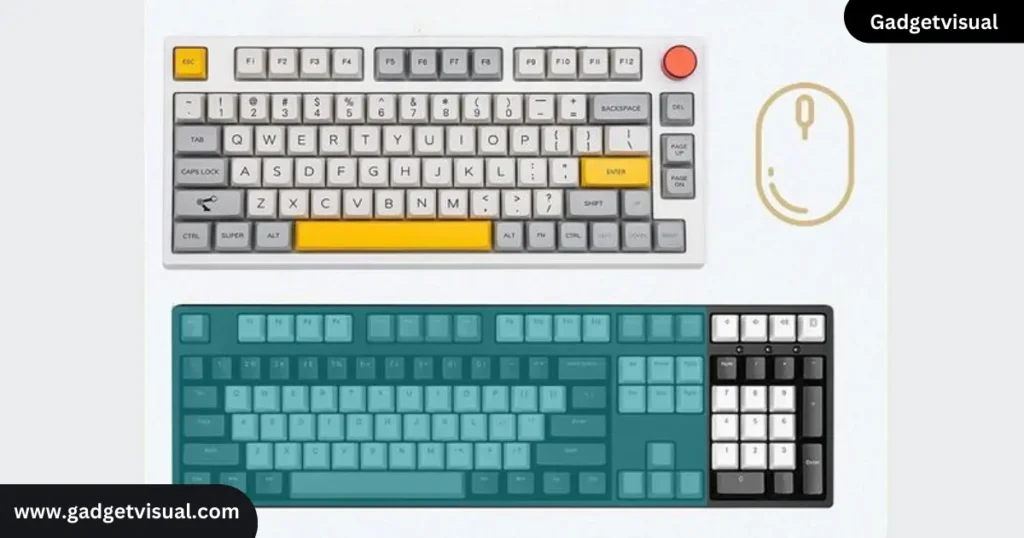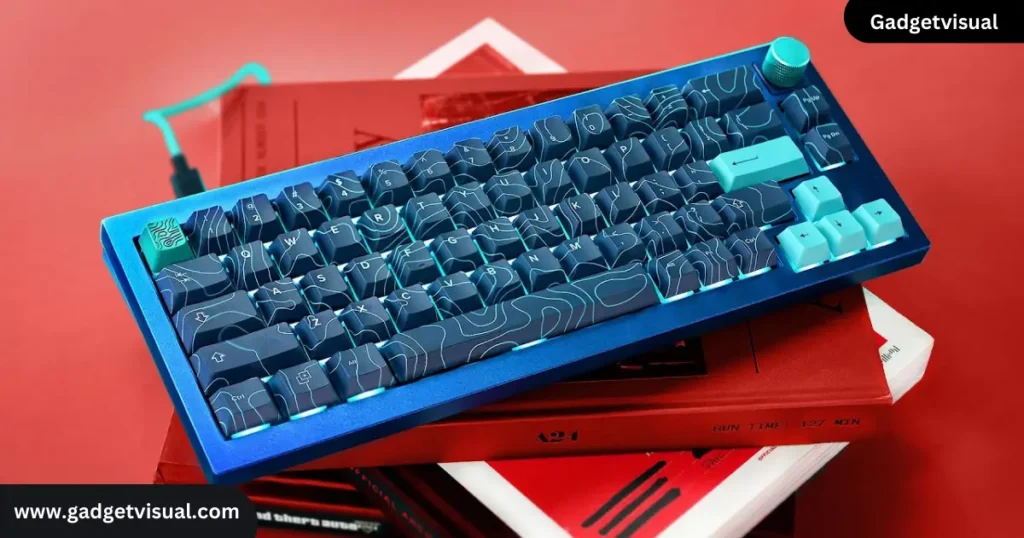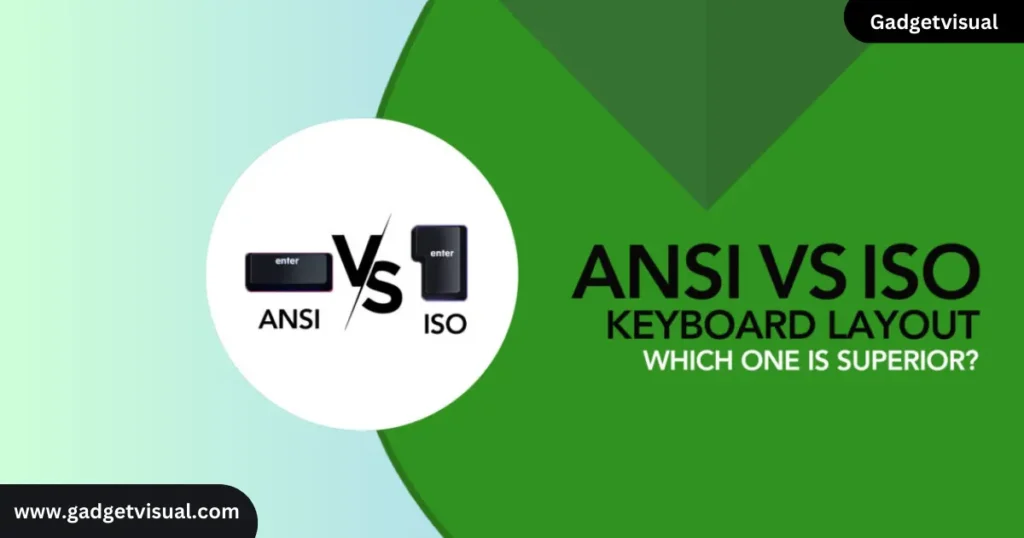Selecting the ideal keyboard entails delving into the nuanced differences between ANSI and ISO layouts, each influencing distinct typing experiences.
ANSI, a standard in North America, and ISO, prevalent in Europe, introduce variations in key size and arrangement. Navigating these distinctions is crucial for users seeking a personalized typing experience.
More fully discuss below. Understanding the disparities between ANSI and ISO keyboards empowers users to make informed decisions based on their unique preferences.
Contents
- 1 1. Understanding ANSI Keyboards: A Keyboard Layout Standard in the United States
- 1.1 1.1 Key Features of ANSI Keyboards:
- 1.2 1.2 Advantages of ANSI Keyboards: Enhancing Efficiency
- 1.3 1.3 Unlocking the Potential: ANSI Keyboards in Action
- 1.4 1.4 Customization and Personalization: Tailoring Your ANSI Keyboard Experience
- 1.5 1.5 ANSI Keyboards in the Modern Era: Compatibility and Connectivity
- 1.6 1.6 Choosing the Perfect ANSI Keyboard: A Buyer’s Guide
- 1.7 1.7 Conclusion: Elevate Your Typing Experience with ANSI Keyboards
- 2 2. Cracking the Code of ISO Keyboards: An Assortment of Layout Features
- 2.1 2.1 Key Features of ISO Keyboards:
- 2.2 2.2 Advantages of ISO Keyboards: Unleashing a Spectrum of Possibilities
- 2.3 2.3 ISO Keyboards in Action: Applications Across Industries
- 2.4 2.4 Customization and Personalization: Tailoring Your ISO Keyboard Experience
- 2.5 2.5 ISO Keyboards in the Modern Workspace: Connectivity and Compatibility
- 2.6 2.7 Conclusion: Elevate Your Typing Experience with ISO Keyboards
- 3 3. ANSI vs ISO Keyboard: Understanding the Key Differences
- 3.1 3.1 Comprehending ANSI vs ISO Layout
- 3.2 3.2 Key Differences Between ANSI and ISO Layouts
- 3.3 3.3 Advantages and Disadvantages of ANSI Layout
- 3.4 3.4 Advantages and Disadvantages of ISO Layout
- 3.5 3.5 In-Depth Comparison of ANSI and ISO Keyboards
- 3.6 3.6 Choosing the Right Keyboard Layout: ANSI or ISO?
- 3.7 3.7 Exploring Additional Features of ANSI and ISO Keyboards
- 3.8 3.8 Conclusive Factors in Choosing the Best Keyboard Layout:
- 3.9 3.9 Key Factors and Considerations for Ergonomic Layouts: ISO vs ANSI
- 3.10 3.10 Impact of ANSI and ISO Layouts on Typing Speed and Efficiency
- 3.11 3.11 Mechanical Keyboards with ANSI and ISO Layouts
- 3.11.1 I. Differences in Key Switches for ANSI and ISO Keyboards
- 3.11.2 II. Keycap Compatibility for Mechanical Keyboards in ANSI and ISO Layouts
- 3.11.3 III. Pros and Cons of Using HHKB Layout with ANSI and ISO Keyboards
- 3.11.4 IV. Utilizing Fully Programmable Keyboards with ANSI and ISO Layouts
- 3.11.5 V. Customization and Adaptability of ANSI and ISO Keyboards for Different Users
- 3.12 3.12 Navigating International Keyboard Layouts: ANSI, ISO, and JIS
- 4 Frequently Asked Questions
1. Understanding ANSI Keyboards: A Keyboard Layout Standard in the United States

ANSI, or the American National Standards Institute, sets the standard for keyboard layouts in the United States. The ANSI keyboard layout is widely recognized for its compact design and specific key arrangement. This distinguishes it from layouts like ISO.
The ANSI layout is characterized by its streamlined and ergonomic design, catering to users who prioritize efficiency in typing. The key placement on an ANSI keyboard follows a distinct pattern, optimizing the layout for users familiar with the English language.
1.1 Key Features of ANSI Keyboards:
- Efficient Design: ANSI keyboards are recognized for their compact and ergonomic design, appealing to users who prioritize typing efficiency.
- Key Placement: The keys on an ANSI keyboard follow a specific pattern, optimizing the layout for users familiar with the English language.
1.2 Advantages of ANSI Keyboards: Enhancing Efficiency
Choosing an ANSI keyboard provides numerous advantages, making it a popular choice for many users.
- Familiarity: The ANSI layout is the standard in the United States, making it a familiar and comfortable choice for users accustomed to this configuration.
- Accessibility: ANSI keyboards are widely available, ensuring easy access to replacement keys, keycaps, and compatible accessories.
- Compact Design: The ANSI layout’s compact design allows for more efficient use of desk space, ideal for users working in confined environments.
1.3 Unlocking the Potential: ANSI Keyboards in Action
- Gaming Excellence: ANSI keyboards are well-suited for gaming enthusiasts, offering a responsive and compact layout that enhances gaming performance.
- Typing Comfort: The familiarity of the ANSI layout contributes to an enhanced typing experience, promoting comfort and reducing the learning curve for new users.
- Coding Efficiency: Programmers and coders often prefer ANSI keyboards for their streamlined design, enabling quick and precise coding sessions.
1.4 Customization and Personalization: Tailoring Your ANSI Keyboard Experience
- Keycap Options: ANSI keyboards provide a variety of keycap customization options, allowing users to personalize their keyboards to match their unique style.
- Backlit Brilliance: Many ANSI keyboards come equipped with customizable backlighting, adding a touch of personalization and functionality to the typing experience.

1.5 ANSI Keyboards in the Modern Era: Compatibility and Connectivity
- USB and Wireless Options: ANSI keyboards are available in both traditional USB and wireless configurations, providing users with flexibility in connectivity.
- Operating System Compatibility: ANSI keyboards seamlessly integrate with various operating systems, ensuring a smooth experience for users across different platforms.
1.6 Choosing the Perfect ANSI Keyboard: A Buyer’s Guide
- Consider Your Usage: Determine your primary use for the keyboard, whether it’s gaming, typing, or coding, to guide your choice.
- Budget Considerations: ANSI keyboards are available in a wide price range, allowing users to find one that fits their budget without compromising on quality.
- Read Reviews: Explore user reviews and expert opinions to gain insights into specific ANSI keyboard models and their performance.
1.7 Conclusion: Elevate Your Typing Experience with ANSI Keyboards
In the world of keyboards, the ANSI layout stands as a symbol of efficiency, familiarity, and adaptability. Whether you’re navigating a gaming marathon, typing a report, or coding your next project, an ANSI keyboard can be your trusted companion. Embrace the power of ANSI and elevate your typing experience to new heights. Happy typing!”
2. Cracking the Code of ISO Keyboards: An Assortment of Layout Features

ISO, short for the International Organization for Standardization, sets the keyboard layout standard in Europe and various other regions. The ISO keyboard layout distinguishes itself from ANSI, offering its own array of features and characteristics.
2.1 Key Features of ISO Keyboards:
- Lengthened Enter Key: The most noticeable divergence in the ISO layout is the elongated Enter key, providing users with a larger target for swift and precise inputs.
- Additional Keys: ISO keyboards often integrate extra keys, such as the supplementary key next to the left Shift key, providing users with increased functionality and adaptability.
2.2 Advantages of ISO Keyboards: Unleashing a Spectrum of Possibilities
Opting for an ISO keyboard brings a multitude of advantages that cater to a diverse user base.
- Multilingual Support: The ISO layout accommodates various languages with its additional keys, making it an excellent choice for users who frequently work with multiple languages.
- Typing Comfort: The elongated Enter key and additional spacing contribute to a comfortable typing experience, reducing the likelihood of unintentional key presses.
- Aesthetic Appeal: Many users appreciate the symmetry and aesthetic charm of the ISO layout, adding a touch of sophistication to their workspace.
2.3 ISO Keyboards in Action: Applications Across Industries
- Language Professionals: Translators, writers, and language professionals benefit from the multilingual support of ISO keyboards, streamlining their workflow.
- Finance and Data Input: The extended Enter key and additional keys make ISO keyboards advantageous for professionals dealing with extensive data input, such as in finance or data analysis.
- Design and Aesthetics: Graphic designers and creatives often prefer ISO keyboards for their symmetrical layout, contributing to an aesthetically pleasing workspace.

2.4 Customization and Personalization: Tailoring Your ISO Keyboard Experience
- Keycap Variety: ISO keyboards offer a wide variety of keycap options, allowing users to customize their keyboards to match their unique preferences and style.
- Backlighting Brilliance: Many ISO keyboards come equipped with customizable backlighting options, providing users with the ability to personalize their typing experience further.
2.5 ISO Keyboards in the Modern Workspace: Connectivity and Compatibility
- USB and Wireless Options: ISO keyboards are available in both traditional USB and wireless configurations, providing users with the flexibility to choose based on their connectivity preferences.
- Operating System Compatibility: ISO keyboards seamlessly integrate with various operating systems, ensuring compatibility with a wide range of devices.
2.6 Choosing the Perfect ISO Keyboard: A Buyer’s Guide
- Language Requirements: If you frequently work with multiple languages, the ISO layout may be the ideal choice for its extended language support.
- Comfort Considerations: Consider the extended Enter key and additional spacing if typing comfort is a priority in your selection process.
- Budget and Features: ISO keyboards come in various price ranges with different features. Evaluate your budget and prioritize the features that align with your specific needs.
2.7 Conclusion: Elevate Your Typing Experience with ISO Keyboards
In the diverse world of keyboards, the ISO layout stands as a testament to versatility, comfort, and aesthetic appeal. Whether you’re a language professional, a data analyst, or a creative mind, an ISO keyboard can enhance your typing experience and bring a touch of sophistication to your workspace. Embrace the unique features of the ISO layout and elevate your typing to new heights. Happy typing!”
Recommended to Read:
How to Connect Logitech Keyboard to MacBook
Key to Success: Unbox the Potential of Custom Keyboard Setup
40% Keyboards: Mastering Minimalist Typing Efficiency
3. ANSI vs ISO Keyboard: Understanding the Key Differences

When choosing a keyboard, it’s essential to grasp the distinctions between ANSI (American National Standards Institute) and ISO (International Organization for Standardization) layouts. These two layouts are the most prevalent globally, each with its unique features.
The primary discrepancy lies in the physical size and arrangement of keys. ANSI, prevalent in North America, features a smaller Enter key and differently shaped Left Shift key than the ISO layout used in Europe and other regions. Additionally, the ANSI layout includes a larger Backspace key and a differently positioned | key.
Understanding these differences is crucial for individuals who switch between keyboard layouts or work in multinational environments. By recognizing the nuances, users can select the layout that best suits their needs, optimizing their typing experience. Whether choosing an ANSI or ISO keyboard, it’s vital to consider specific preferences and requirements.
3.1 Comprehending ANSI vs ISO Layout
ANSI and ISO, major keyboard layouts, differ in the size and placement of specific keys. These physical layouts shape the keyboard’s form and key positions, distinct from logical layouts like QWERTY or Dvorak, determining key mappings.
3.2 Key Differences Between ANSI and ISO Layouts
The main differences include:
- Enter key: ANSI has a wide rectangular key, while ISO features an upside-down L-shaped key over two rows.
- Left Shift key: ANSI has a full-length left shift key, while ISO’s is smaller to accommodate additional keys.
- Backslash key: ISO’s layout has a smaller and differently positioned backslash key.
- Right Alt key: ANSI has Alt keys on both sides, while ISO replaces the right Alt with Alt Gr.
- Total keys: ISO keyboards have 105/88 keys vs ANSI’s 104/87.
3.3 Advantages and Disadvantages of ANSI Layout
Advantages:
- Wider, easier-to-press Enter key placed closer to the right side.
- Identical size for left and right Shift keys.
- Enhanced accessibility for alternate key functions.
Disadvantages:
- Difficulty in typing certain non-English characters and diacritics.
- Non-standardized for non-US keyboards.
3.4 Advantages and Disadvantages of ISO Layout
Advantages:
- Extra key allows access to special characters and diacritics.
- Accommodates a wider range of languages, common in European and non-US keyboards.
Disadvantages:
- Smaller left Shift key can lead to miskeys.
- Less ergonomic Enter key placement for some users.

3.5 In-Depth Comparison of ANSI and ISO Keyboards
When deciding between ANSI and ISO layouts, users should consider language needs, key placement, available keycaps and keyboards, and personal preferences. Neither layout is objectively superior; each has advantages catering to different users.
3.6 Choosing the Right Keyboard Layout: ANSI or ISO?
The decision comes down to language needs and personal preference:
- For English typing, ANSI allows easier access to symbols, while ISO’s Enter key position may be a common complaint.
- For European languages, ISO provides better access to diacritics like umlauts.
- For multilingual use, ISO keyboards offer more flexibility with the extra key for additional symbols.
Most keyboards are available in both ANSI and ISO layouts. Trying different mechanical keyboards can help determine preferred sizes and key placements. Keycap compatibility should also be considered.
3.7 Exploring Additional Features of ANSI and ISO Keyboards
Apart from major differences in Enter, left Shift, and right Alt keys, ANSI and ISO keyboards have subtle variations in the Enter key shape, keycaps, modifier keys, backslash key, mechanical keyboards, and overall typing experience.
3.8 Conclusive Factors in Choosing the Best Keyboard Layout:
ANSI or ISO For most users, the choice depends on language typing needs, available keyboard options, personal layout familiarity, and typing efficiency. Neither layout is objectively superior, but testing different mechanical keyboards helps determine the best fit based on individual preferences.
3.9 Key Factors and Considerations for Ergonomic Layouts: ISO vs ANSI
Ergonomic differences arise from the size and placement of keys:
- ANSI’s wide Enter key allows a natural right-hand position.
- ISO’s vertically aligned keys may limit wrist flexion for some.
- ISO’s smaller left Shift increases reach and miskey chances.
- ANSI relies on more modifier combos, potentially causing strain.
Testing different keyboard sizes and switches in both layouts is ideal for finding the optimal fit. ISO’s layout may lead to more strain over extended typing periods for some users.
3.10 Impact of ANSI and ISO Layouts on Typing Speed and Efficiency
The physical layout can influence typing speed and accuracy. ANSI may offer better efficiency for English typing, while ISO’s smaller left Shift may cause more miskeys. Typing speed depends on personal preference and comfort with a layout, with both ANSI and ISO allowing efficient typing for different use cases.
3.11 Mechanical Keyboards with ANSI and ISO Layouts
Why Mechanical Keyboards are Popular in ANSI Layout The standardized key arrangement and tactile feedback of ANSI layouts make mechanical keyboards popular for their efficiency and performance. Mechanical keyboards in ANSI layout are preferred by professionals and enthusiasts for their ease of transition and customizable key switches.
I. Differences in Key Switches for ANSI and ISO Keyboards
ANSI keyboards predominantly use Cherry MX switches, while ISO keyboards often use alternative brands like Kailh or Gateron. Sizing and placement variations result in distinct typing experiences.
II. Keycap Compatibility for Mechanical Keyboards in ANSI and ISO Layouts
Keycap compatibility is crucial for keyboard enthusiasts. ANSI keycaps fit most US keyboards, while ISO keycaps are designed for European keyboards. Understanding differences and compatibility ensures a proper fit and optimal typing experience.
III. Pros and Cons of Using HHKB Layout with ANSI and ISO Keyboards
The HHKB layout’s compact design suits minimalists, but it may not be ideal for those accustomed to traditional ANSI or ISO layouts. Finding compatible keycaps and replacement parts can be challenging.
IV. Utilizing Fully Programmable Keyboards with ANSI and ISO Layouts
Fully programmable keyboards offer versatility and customization for individual preferences. The ability to reassign keys and create macros benefits users requiring specific layouts for languages or tasks.
V. Customization and Adaptability of ANSI and ISO Keyboards for Different Users
Both layouts allow customization through aftermarket keycaps, mechanical keyboard modifications, fully programmable PCBs, and alternative layouts like HHKB. ANSI keyboards offer more physical customization options, while software customization works well for both layouts.

Understanding differences between ANSI, ISO, and JIS (Japanese Industrial Standards) layouts aids in international keyboard selection:
JIS vs ANSI/ISO:
- JIS has an extra key and differently placed Z and Y keys compared to ANSI, sharing some visual commonality with ISO.
- Unique JIS-specific keycaps may face compatibility issues on ISO/ANSI keyboards. Language Considerations:
- ANSI is optimized for English typing.
- ISO accommodates European languages.
- JIS is specifically suited for Japanese.
Choosing Keyboard Layouts for Different Language Support Selecting a layout based on language needs involves considerations:
For English:
- ANSI provides accessibility to symbols while typing sentences.
- ISO’s Enter key may require adjustment for some English users.
European Languages:
- ISO offers native access to accented characters.
- ANSI requires memorizing combos, reducing typing speed.
Asian Languages:
- JIS fits Japanese and Chinese typing needs best.
- ISO/ANSI limit typing efficiency for complex Asian characters.
For Multilingual Use:
- ISO is a middle ground for European languages.
- Fully programmable boards adapt any layout to multiple languages. Testing different layouts suited for intended language use is recommended. Prioritizing efficiency vs. customization helps determine the ideal layout.”
Frequently Asked Questions
The key size and arrangement distinguish ANSI and ISO keyboards. ANSI, commonly used in North America, has a smaller Enter key and a unique Left Shift key compared to ISO, widely utilized in Europe.
Typing comfort is influenced by the different key positions in ANSI and ISO layouts. Understanding these differences helps users choose a layout that suits their ergonomic preferences.
Yes, both layouts have their advantages and disadvantages. ANSI may offer broader access to symbols, while ISO provides additional keys for multilingual support. The best choice depends on individual preferences and language needs.
Switching between ANSI and ISO keyboards might require some adjustment due to differences in key sizes and positions. However, users can adapt over time with regular use and practice.
Certainly. While ANSI keyboards may have a wider range of aftermarket keycap choices, ISO layouts also offer plenty of opportunities for customization. Users can personalize their keyboards according to their preferences.
For more information on gaming keyboard, check out our Logitech vs Razer and Productivity Keyboard. If you’re interested in a Gaming Keyboard Layout, explore our guide here.










